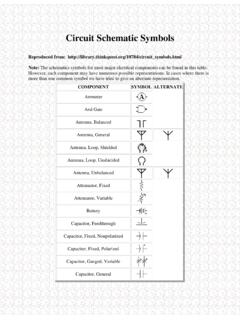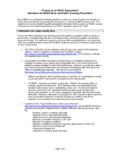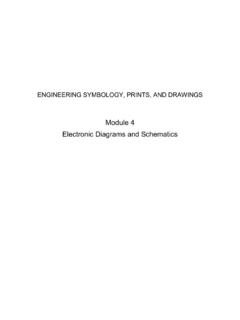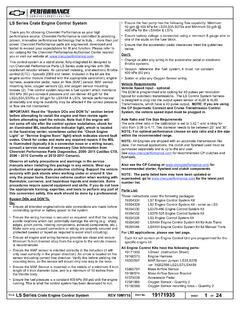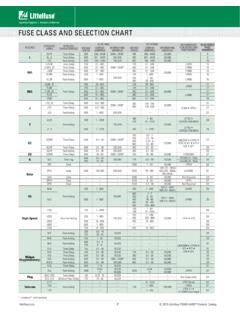Transcription of Electrical Safety - Occupational Safety and Health ...
1 FOCUS 4 Electrical SafetyParticipant GuideCONSTRUCTION Safety & HEALTHThis material was produced under grant number SH-16586-07-06-F-36 from the Occupational Safety and Health Administration, Depart-ment of Labor. It does not necessarily refl ect the views or policies of the Department of Labor, nor does mention of trade names, commercial products, or organizations imply endorsement by the #4 | Participant Guide1 Electrical SafetySECTION #4 Curriculum on Electrical SafetymGOALmTo provide a basic understanding of how electricity works and how to protect ourselves from common Electrical hazards, both on and off the is the fourth leading cause of work-related death for construction workers. On average, one worker is electrocuted on the job every day in the United AND LIMITATIONSThis training curriculum is primarily designed for workers without any formal training on electricity, although electricians may also benefi t from a review. The document focuses on some of the fundamentals of electricity, Electrical wiring, electric tools, protective methods and devices, and related work methods and safe practices in the construction material is presented using an interactive training curriculum focuses on common AC wiring, as found in homes and on construction sites.
2 It also includes information on power line curriculum is not all-inclusive. It does not cover every Electrical hazard nor does it describe every applicable OSHA Electrical have drawn extensively from several sources in preparing this material. These include: Electrical Safety for Non-Electricians, by CSEA/Local 1,000 AFSCME Electrical Safety : Safety and Health for Electrical Trades, by NIOSH Thanks to the Construction Safety Council for permission to use their information on power line Safety . Various training materials found on OSHA and NIOSH #4 | Participant Guide2 Electrical SafetymELECTRICAL SAFETYmmACTIVITY 1 GROUNDINGmIn your small group, read fact sheets A and B, and the following scenario. Then answer the questions :You encounter a co-worker on a residential remodeling job. She has an older drill with a steel housing and a 3-prong plug. The wiring in the building has only two-slot receptacles with no equipment ground slot. She is just about to break off the grounding prong on the tool s plug with a pair of pliers when you ask her to What do you say to your co-worker about this problem?
3 2. What can you do to correct this problem?3. What is the best way to deal with this?Safe Work: GROUNDED tool with 3-prong POLARIZED plug, GROUNDED #4 | Participant Guide3 Electrical SafetymACTIVITY 1 GROUNDINGmFactsheet A Two Ways to Wire an Electric ToolOSHA CONSTRUCTION INDUSTRY STANDARDS (a)Electric power-operated (a) (1)Electric power operated tools shall either be of the approved double-insulated type or grounded in accordance with Subpart K of this DOES THAT MEAN?There are two different ways of wiring an Electrical tool: double insulation or the use of equipment grounding. First of all, the individual wires in the tool and cord are insulated and the cord itself is also insulated. These are the fi rst level of the double insulation method, the manufacturer provides a second level of insulation inside the tool, to reduce the risk of a damaged hot wire within the tool (generally at 120 volts AC) from coming in contact with any exposed metal on the insulation protects you by providing another insulation barrier, preventing a wiring defect that could allow an energized conductor to touch any metal on the tool that you can touch.
4 A double insulated tool will be marked on its handle or on a data label with the words Double Insulated or with a symbol: a square box within a the equipment grounding method, a third wire is added to the tool s wiring and connected to a round pin on the tool s plug. The other end of this grounding wire is connected to the metal frame of the tool. The 3-conductor plug on the tool must be plugged into a grounded outlet. The equipment ground connection on the outlet must be connected to a grounding connection at the Electrical panel. The steel Electrical panel is then connected to the earth. This is generally done via clamping a system ground wire to a METAL cold water pipe or to ground rods driven into the grounding only works when there is a permanent and continuous Electrical connection between the metal shell of a tool and the earth. If a wiring defect in the tool allows an energized wire to touch the tool s metal shell, grounding provides a low resistance path to earth for the resulting current.
5 This will generally allow enough current to fl ow so that a fuse will blow or a circuit breaker is tripped, thus turning off the electricity in that circuit. If this grounding path is broken at any point, the tool is NOT GROUNDED and the operator is at risk of shock or Electrical tools and equipment must be maintained in safe condition and checked regularly for defects. They must be taken out of service if a defect is #4 | Participant Guide4 Electrical SafetymACTIVITY 1 GROUNDINGmFactsheet B Install a Grounded OutletOccasionally you will encounter a building with older wiring, having receptacles with only two slots (called hot and neutral ). These older receptacles don t contain a round slot for the equipment ground. If you have a tool with a 3-prong plug, this is a best solution is to have a licensed electrician install one or more grounded outlets. Of course, this will take some time and money. Is there anything else you can do instead? Here are three possibilities:In the United States (but not in Canada) you can buy a 3-prong adaptor.
6 This is not a good idea unless you re sure of what you re doing. These adaptors generally come with either a small metal tab (to be attached to the screw securing a receptacle to its box cover) or with a short wire (often with green insulation and a thin, bare lug at the end of the wire). In theory, you can attach the metal tab or the grounding wire to a grounded screw in a grounded receptacle, thereby getting your equipment ground connection. If you don t know what you re doing, such as, if there s no proper ground at the receptacle, there is no equipment ground, therefore, no protection from Electrical possible alternative is to get your power from a grounded generator supplying a 120 volts AC grounded outlet. (Of course, your generator must be outdoors so hazardous engine exhaust can t enter your work area, and you ll need a grounded extension cord.)Finally, you could do your work with cordless tools, operating at a relatively low DC voltage with re-chargeable batteries.
7 This method would eliminate the 120 volts AC Electrical hazard you d otherwise break off a grounding prong from a 3-conductor plug. Your tools will still work, but you will have NO PROTECTION from a dangerous Electrical shock in the event of an Electrical defect in the tool!SECTION #4 | Participant Guide5 Electrical SafetymELECTRICAL SAFETYmmACTIVITY 2 IMPROPER WIRING / REVERSED POLARITYmIn your small group, read fact sheets C and D, and the following scenario. Then answer the questions :You are a supervisor in a small construction company. A worker passing you in a hallway mentions that he thought he just felt a tingle after he plugged in an old fl oor lamp. He had touched a metal shell, the outside housing around a socket for the light bulb. You ask him to take you to the lamp. You unplug it and notice a two-prong plug, with both prongs the same size. You tell the worker, I think I know what happened. We ll get this fi xed. Let me explain it to you.
8 1. What is your explanation to the worker?2. What are some steps to deal with this issue?3. What is the best way to correct the problem?Possibly Unsafe: 2-prong NON-POLARIZED plug could be plugged-in backwards and result in electric shock if lamp is defective (see text).SECTION #4 | Participant Guide6 Electrical SafetymACTIVITY 2 IMPROPER WIRING / REVERSED POLARITYmFactsheet C Conductors, Connections and PolarityIt takes a minimum of two wires to have an Electrical circuit. Electric current involves the fl ow of electrons. Current is measured in amperes (amps for short). It travels from a source, through the device it operates, called the load, and then back to the source. In AC wiring, present in buildings, there is voltage present on the hot wire (generally at about 120 volts AC). Voltage provides the force that allows electrons to fl ow in a circuit. Switches on Electrical devices are supposed to be wired only on the hot or live side of the circuit.
9 The return conductor, known as the neutral, is at zero volts because it is deliberately grounded at the Electrical panel. [See Activity 1 for more about Electrical grounding.] The amount of current that fl ows in a circuit depends on its Electrical resistance, or opposition to current fl ow, measured in an Electrical shock, the amount of Electrical current, in amps, that fl ows through your body goes up when resistance in ohms goes Current in Amps = Voltage in Volts DIVIDED BY Resistance in VOLTAGE = more current (if resistance remains the same).LOWER RESISTANCE = more current (if voltage remains the same).Newer electric plugs have blades that are polarized, so the hot wire on the device is connected to the hot side of the Electrical receptacle, and the neutral wire is connected to the neutral side. This is done by making the neutral blade on the plug wider than the hot blade. If you look at a grounded outlet, you ll see that the hot slot is shorter than the neutral plugs may not be polarized, and both blades are the same size.
10 It s best to have an electrician re-wire the device using a polarized plug. The electrician should also ensure that the receptacle is properly install grounded circuits. They follow OSHA s Lockout/Tagout standard when working on them. Circuits are de-energized and isolated. Stored energy is released and conductors are grounded. De-activated controls are then locked out, and tags are placed at their off install grounded circuits. They follow OSHA s Lockout/Tagout standard when working on them. Circuits are de-energized and isolated. Stored energy is released and conductors are grounded. De-activated controls are then locked out, and tags are placed at their off #4 | Participant Guide7 Electrical SafetymACTIVITY 2 IMPROPER WIRING / REVERSED POLARITYmFactsheet D Reversed Polarity Can Kill!What can happen if a neutral wire of a device is connected to the hot side of a circuit? This condition is known as reversed polarity.










